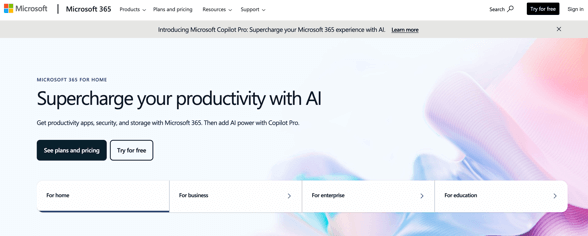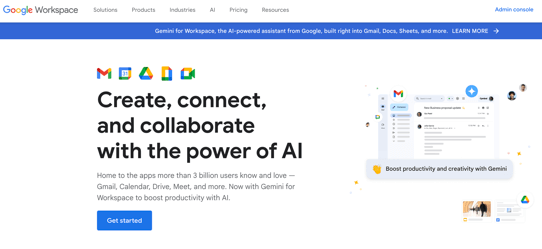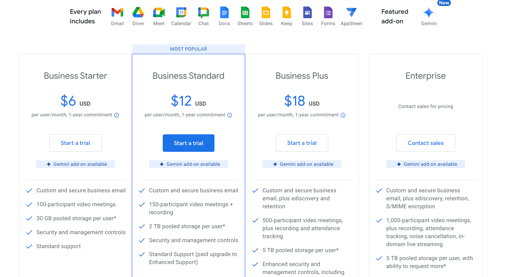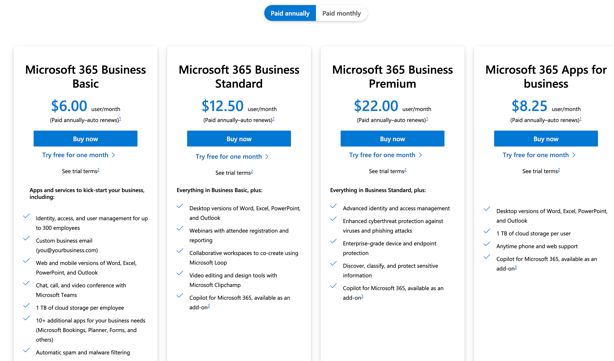Choosing the right productivity suite is crucial for operational efficiency and collaboration.
Google Workspace and Microsoft 365 are the two leading contenders in this space, each offering a suite of tools designed to enhance productivity, communication, and collaboration.
This article delves into a detailed comparison of Google Workspace and Microsoft 365, exploring their features, pricing, security, and more, to help you make an informed decision.
Background and Evolution (Microsoft 365 vs Google Workspace)

Microsoft 365, originally branded as Office 365, has a rich history dating back to 1988 with the launch of Microsoft Office. Over time, it has transformed from desktop software to a cloud-based suite, incorporating services like OneDrive and Microsoft Teams.
The rebranding to Microsoft 365 in 2020 signifies its shift towards a more integrated and cloud-centric offering.

Google Workspace, formerly known as G Suite, was launched in 2006. Over the years, it has evolved from a simple collection of Google’s web-based apps to a comprehensive suite designed for business use.
Major milestones include the introduction of Google Docs in 2006, the integration of AI features, and the rebranding to Google Workspace in 2020 to reflect its comprehensive nature.
Google Workspace vs Microsoft 365 Comparison Overview
| Feature | Google Workspace | Microsoft 365 |
| Gmail | Outlook | |
| Calendar | Google Calendar | Outlook Calendar |
| Document Management | Google Drive, Google Docs | OneDrive, Microsoft Word |
| Spreadsheet | Google Sheets | Microsoft Excel |
| Presentation | Google Slides | Microsoft PowerPoint |
| Communication Tools | Google Meet, Google Chat, Google Hangouts | Microsoft Teams, Skype, Yammer |
| Real-time Collaboration | Yes, integrated across all apps | Yes, integrated across all apps |
| Security Features | Two-factor authentication, encryption, advanced protection | Advanced Threat Protection, Data Loss Prevention, MFA |
| Compliance | GDPR, HIPAA, ISO/IEC 27018 | GDPR, HIPAA, FedRAMP |
| Pricing (Per User/Month) | Business Starter: $6, Business Standard: $12, Business Plus: $18 | Business Basic: $5, Business Standard: $12.50, Business Premium: $20 |
| User Interface | Clean, intuitive, easy to use | Feature-rich: Can be complex for new users |
| Integration | Seamless with Google services, wide third-party app support | Extensive third-party app support, deep Windows integration |
| Compatibility | Windows, macOS, Android, iOS | Windows, macOS, Android, iOS |
| Customer Support | 24/7 phone, email, chat, help center, community forums | 24/7 phone, web support, online resources, training |
| Reliability | High uptime, strong support infrastructure | High uptime, strong support infrastructure |
| Advantages | User-friendly, real-time collaboration, strong search, competitive pricing | Comprehensive tools, advanced features, robust security |
| Disadvantages | Limited advanced features, less familiar for traditional office users | A steeper learning curve, higher cost for premium plans |
Core Features Comparison
Email and Calendar
- Gmail vs. Outlook: Gmail is known for its simplicity and powerful search capabilities, while Outlook offers a more traditional email interface with robust organizational tools and integration with other Microsoft apps.
- Google Calendar vs. Outlook Calendar: Both calendars offer similar features, including event scheduling, sharing, and integration with email. Google Calendar is praised for its clean interface and ease of use, whereas Outlook Calendar is appreciated for its deep integration with other Microsoft 365 tools.
Document and File Management
- Google Drive and Google Docs vs. OneDrive and Microsoft Word: Google Drive provides seamless collaboration with Google Docs, Sheets, and Slides. Microsoft OneDrive offers deep integration with Microsoft Office applications, including Word, Excel, and PowerPoint, which are industry standards for document creation.
Spreadsheets and Presentations
- Google Sheets and Google Slides vs. Microsoft Excel and PowerPoint: Google Sheets and Slides excel in real-time collaboration and ease of use. Microsoft Excel is the gold standard for data analysis and complex calculations, while PowerPoint is renowned for its advanced presentation capabilities.
Communication Tools
- Google Meet, Chat, and Hangouts vs. Microsoft Teams, Skype, and Yammer: Google Workspace offers Google Meet for video conferencing and Google Chat for messaging, integrated within the suite. Microsoft Teams is a robust collaboration platform that combines video conferencing, chat, and file sharing, offering a more integrated experience.
Collaboration and Productivity Tools
Both Google Workspace and Microsoft 365 excel in collaboration. Google’s tools allow multiple users to work on the same document simultaneously, with changes reflected in real time.
Microsoft 365 also offers real-time collaboration, with additional features like version history and more advanced formatting options. Both suites integrate well with third-party applications, enhancing their functionality.
Security and Compliance
- Google Workspace: Google Workspace provides robust security features, including two-factor authentication, encryption in transit and at rest, and advanced phishing and malware protection. It complies with global standards like GDPR, HIPAA, and ISO/IEC 27018.
- Microsoft 365: Microsoft 365 also offers comprehensive security measures, such as Advanced Threat Protection, Data Loss Prevention, and multi-factor authentication. It adheres to a wide range of compliance standards, including GDPR, HIPAA, and FedRAMP.
Pricing and Plans
Google Workspace Pricing Tiers:

Google Workspace offers several pricing plans, starting with Business Starter at $6 per user per month, Business Standard at $12 per user per month, and Business Plus at $18 per user per month. There is also an Enterprise plan with custom pricing.
Microsoft 365 Pricing Tiers:

Microsoft 365 has a variety of plans, including Microsoft 365 Business Basic at $5 per user per month, Microsoft 365 Business Standard at $12.50 per user per month, and Microsoft 365 Business Premium at $22 per user per month. Enterprise plans are also available.
Microsoft 365 offers pricing for home users too. For personal use, it is priced at $69.99/year, and Microsoft 365 Family price is at $99.99/year for up to 6 users.
User Experience and Interface
Google Workspace is praised for its clean, intuitive interface, which is easy to navigate and use. Its tools are designed with simplicity in mind, making them accessible to users of all skill levels.
Microsoft 365 offers a more feature-rich interface, which can be overwhelming for new users but provides advanced functionality for power users. The integration of AI and machine learning in both suites enhances user experience by offering smart suggestions and automation.
Integration and Compatibility
Google Workspace integrates seamlessly with other Google services and a wide range of third-party applications. It is compatible with various devices and operating systems, including Windows, macOS, Android, and iOS.
Microsoft 365 also offers extensive integration with third-party apps and services, and its applications are available on all major platforms. The deep integration with Windows OS provides an added advantage for Windows users.
Customer Support and Reliability
- Google Workspace Support: Google offers 24/7 customer support via phone, email, and chat for all its Workspace plans. Additionally, it provides a comprehensive help center and community forums.
- Microsoft 365 Support: Microsoft provides 24/7 phone and web support for its Microsoft 365 subscribers. It also offers extensive online resources, including a knowledge base, community forums, and training modules.
Case Studies and Examples
Several businesses have successfully adopted Google Workspace for its simplicity and collaborative features. For instance, Colgate-Palmolive reported a 25% reduction in IT support tickets after switching to Google Workspace.
On the other hand, Microsoft 365 is favored by large enterprises like Walmart, which benefits from its robust security and integration capabilities. Both suites have numerous success stories showcasing their impact on productivity and efficiency.
Pros and Cons
Google Workspace:
- Advantages: User-friendly interface, seamless collaboration, strong search capabilities, competitive pricing.
- Disadvantages: Limited advanced features in comparison to Microsoft 365, less familiar to users of traditional office software.
Microsoft 365:
- Advantages: Comprehensive suite of tools, advanced features, deep integration with Windows, robust security.
- Disadvantages: Steeper learning curve, higher cost for premium plans, can be overwhelming for new users.
Which One is Right for Your Business?
Choosing between Google Workspace and Microsoft 365 depends on your business needs. Google Workspace is ideal for small to medium-sized businesses looking for ease of use and real-time collaboration.
Microsoft 365 is better suited for larger enterprises requiring advanced features and robust security. Consider factors such as your existing software ecosystem, budget, and specific business requirements when making your decision.
Conclusion
Both Google Workspace and Microsoft 365 offer powerful productivity tools that can enhance your business operations. By understanding their differences and evaluating your business needs, you can choose the suite that best aligns with your goals.
Whether you prioritize collaboration, security, or advanced features, both suites provide comprehensive solutions to help your business thrive.
More Readings:

